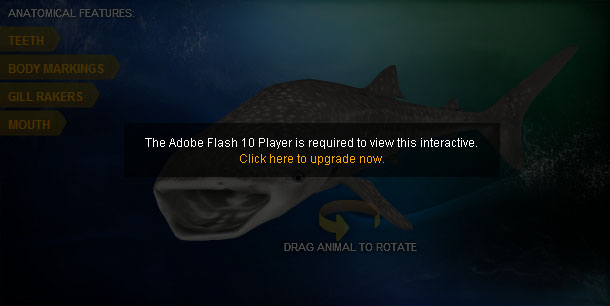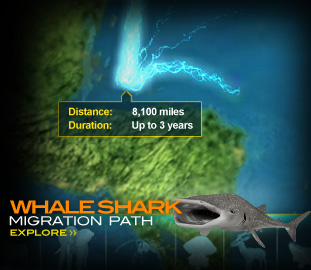Whale Shark
Animals — Whale Shark
INTERACTIVE WHALE SHARK PROFILE
WHALE SHARK (Rhincodon typus)
The whale shark is one of only three varieties of filter-feeding sharks (the basking and megamouth are the others). The species also is closely related to the bottom-dwelling sharks (Orectolobiformes), which include the wobbegong. There are no reliable estimates of the worldwide whale shark population, but indications are that the species is extremely rare. Prior to the mid-1980s, there were only 350 recorded sightings of whale sharks worldwide. In recent years, there have been numerous sightings in Australian waters. Whale sharks have been sighted off the coasts of of Australia, India, the Maldives, South Africa, Belize, Mexico, the Galapagos Islands, Southeast Asia and Indonesia.
While whale sharks’ massive bodies might make them seem like scary super-predators, they pose no danger to humans or large mammals or fish. Instead, they dine upon upon krill and squid, and small fish such as sardines, anchovies, and mackerel. Instead of biting its food, like a great white, the whale shark juts out its big jaws and sucks in the water around it, along with whatever is in the water. It then shuts its mouth, forcing the water to filter through its gills. Everything that remains in its filters becomes the giant creature’s dinner. The whale shark itself is preyed upon by human fishermen. Whale sharks are caught and sold for food when tuna, marlin, or other large high-priced fish are scarce.
It is difficult to observe whale sharks in the wild, and most of the sightings are of juvenile males in coastal areas, where they gather to feed . But adult whale sharks’ precise movements remain mysterious, they are believed to spend much of their time in the ocean deep, far from shore, and to go on long, multi-year journeys, during which they visit cold-water areas that are richer in food. Most of the knowledge about whale shark migration is from acoustic tracking. Scientists hope to learn more by tagging individuals and following them via satellite.
MORE MIGRATIONS
-
Preserve their HabitatHelp conserve the natural landscapes of these migratory species.
-
Teacher ResourcesJoin the virtual assembly and access lesson plans specific to your area.
-
Nat Geo ExpeditionsTake a migration of your own with National Geographic Explorers.
-
Science Behind MigrationsHow do animals decide where to go, how long to stay, and when to leave?













